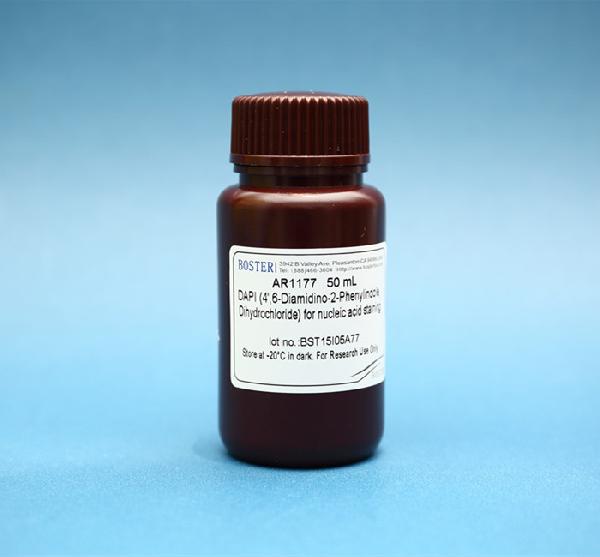Product Info Summary
| SKU: | AR1176 |
|---|---|
| Size: | From 10mL to 50mL |
Product info
Product Overview
| Product Name | DAPI (4',6-Diamidino-2-Phenylindole, Dihydrochloride) for nucleic acid staining |
|---|---|
| Material | DAPI dihydrochloride (MW = 350.3) |
| Form | Liquid |
| Size | 10 mL (100 assays)/50 mL (500 assays) |
| Concentration | 1μg/ml |
| Buffer | 8 mM sodium phosphate, 2 mM potassium phosphate, 140 mM sodium chloride, 10 mM potassium chloride; pH 7.4. |
| Storage | Upon receipt store at -20°C, protect from light. |
| Stability | When stored as directed, product should be stable for one year. |
| Molecular formula | C16H15N5 • 2 HCL |
| Excitation: DAPI | 340nm |
| Emission: DAPI | 488nm |
| Excitation: DAPI-DNA complexes | 360nm |
| Emission: DAPI-DNA complexes | 460nm |
| Equivalent | Thermofisher (Product No. 62247); Thermofisher (Product No. 62248); Millipore Sigma (Product No. D9542) |
Notes
| Type of DAPI | Molecular formula | Molecular weight | Catalog Number |
| DAPI dihydrochloride | C16H15N5 • 2 HCL | 350.25 | AR1176-10 |
| DAPI dilactate | C16H15N5 • 2 C3H6O3 | 457.48 | N/A |
Introduction
DAPI (4',6-diamidino-2-phenylindole) is a fluorescent dye which can bind DNA strands robustly, the fluorescence being detected by fluorescence microscope. DAPI can dye both live and fixed cells as it can cross intact membrane, with higher efficiency in fixed cells. The molecular formula is C16H15N5•2HCl with 350.25 g/mol molecular weight, CAS Number 28718-90-3. DAPI could pass through the cell and nucleic membranes and bind the double-strand DNA in the nucleus, producing 20 times stronger fluorescence than itself. The efficiency detected by fluorescence microscope is very high (almost 100%), having no side effects for the live cells. The sensitivity for double stranded DNA DAPI staining is many times larger comparing to ethidium bromide (EB). DAPI staining is usually used in cell death detection, as it enters more effectively and generates stronger fluorescence in dead cells. After staining with DAPI, detect with fluorescence microscope or flow cytometry. Blue fluorescent cell would be seen under the microscope after staining. The largest excitation wavelength for DAPI is 340nm (ultraviolet), and the largest emission wavelength is 488nm (blue). When DAPI binds with double-strand DNA, the largest excitation wavelength is 360nm, while the largest emission wavelength becomes 460nm. DAPI's blue emission makes it suitable for combined assays where the fluorescence ranges of DAPI and other IHC-employed fluorescent molecules like green-fluorescent fluorescein and GFP, or red-fluorescent stains like Texas Red, are completely distinctive.
Properties
| Enzymatic Activity | DNase-, RNase-, Protease- free |
|---|---|
| Cell Permeability | Intact membrane permeant |
| Sub-Cellular Localization: | Nucleus |
| Biomolecule Reactivity | Specific binding to AT-base pairs; intercalation into GC-base pairs; |
| Cite This Product | DAPI (4',6-Diamidino-2-Phenylindole, Dihydrochloride) for nucleic acid staining (Boster Biological Technology, Pleasanton CA, USA, Catalog # AR1176) |
Application
Fluorescent bioimaging; Immunofluorescence assays, flow cytometry; in situ hybridization; hystology; IHC; HCS; quantification of DNA content; labeling of DNA in cell cultures; cell death detection
Usage and Handling
- For DNA and chromosomes staining, In vitro laboratory use only. Not for any clinical, therapeutic, or diagnostic use in humans or animals. Not for animal or human consumption.
- DAPI is a known mutagen and should be handled with care.
Protocol
1. Fixed cells and tissues: wash appropriately to remove fixative. If necessary, immunofluorescent staining can be performed first, then perform the DAPI staining. If there is no other staining, perform DAPI staining directly.
Adherent cells or tissue slices: add a sufficient volume of DAPI stain solution to completely cover the sample.
Suspension cells: Add DAPI stain solution to suspend cell pellets at 3:1. Vortex to obtain an even suspension.
2. Incubate for 5-10 minutes at RT (room temperature).
3. Remove the stain solution.
4. Wash with TBST, PBS or physiological saline for 2-3 times, 3-5 minutes each.
5. Observe the sample under fluorescence microscope (excitation wavelength: 360nm, emission wavelength:460nm).
Notes:
1. Use Boster Antifade Mounting Medium (Product No. AR1109) to prevent rapid photobleaching of fluorescence within spectrum range.
2. Please wear the lab coat and disposable gloves to operate.
Chemical Information
| Chemical Name | 4′,6-Diamidino-2-phenylindole dihydrochloride |
|---|---|
| IUPAC Name | 2- (4-Amidinophenyl)-1H-indole-6-carboxamidine dihidrochloride |
| Molecular Formula | C16H15N5·2HCl; C16H17Cl2N5 |
| Molecular Weight | 350.25 |
| CAS | 28718-90-3 |
| EC Number | 249-186-7 |
| Chemical Sources | ChEMBL: CHEMBL48217; CHEMBL531243; SCHEMBL2464378; CHEMBL545547 |
| CHEBI: CHEBI:51231 | |
| ChemSpider: 2848; 123458; 140783 | |
| PubChem: 2954; 21924871; 67094309; 160166 |
Product Images
Validation Images & Assay Conditions

Click image to see more details

Click image to see more details

Click image to see more details
NIH-3T3 cells were grown in 96 well plates, fixed with paraformaldehyde and permeabilized. Then incubate with Boster DAPI solution for 5 minutes.
Specific Publications For AR1176
Loading publications
Customer Reviews
Have you used DAPI (4',6-Diamidino-2-Phenylindole, Dihydrochloride) for nucleic acid staining?
Submit a review and receive an Amazon gift card.
- $30 for a review with an image
0 Reviews For DAPI (4',6-Diamidino-2-Phenylindole, Dihydrochloride) for nucleic acid staining
Customer Q&As
Have a question?
Find answers in Q&As, reviews.
Can't find your answer?
Submit your question
2 Customer Q&As for DAPI (4',6-Diamidino-2-Phenylindole, Dihydrochloride) for nucleic acid staining
Question
Do you have a long term storage information about AR1176 and for how long is it stable if aliquoted at 1ug/mL in -20C?
Verified customer
Asked: 2022-07-27
Answer
The DAPI (4',6-Diamidino-2-Phenylindole, Dihydrochloride) For Nucleic Acid Staining (AR1176) is stable at -20C for at least 1 year even if aliquoted at 1ug/mL
Boster Scientific Support
Answered: 2022-07-27
Question
What is the approximate DAPI concentration in this solution?
Verified Customer
Verified customer
Asked: 2020-01-01
Answer
The concentration is about 1 µg/mL.
Boster Scientific Support
Answered: 2020-01-01



